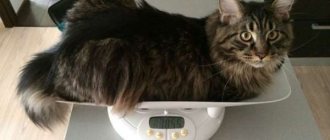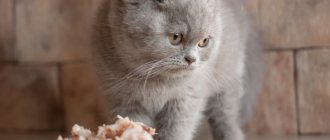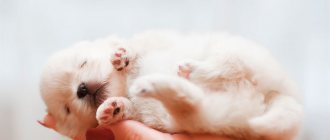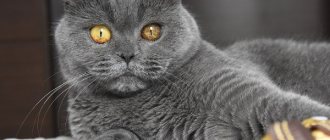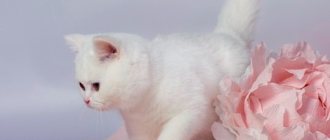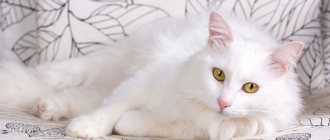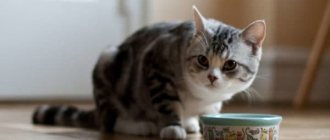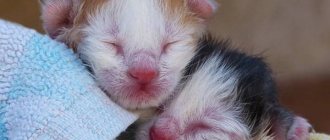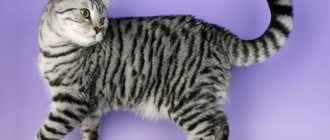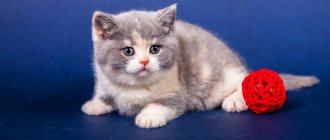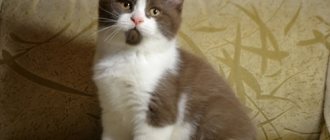When getting a British breed kitten, you need to take into account all the care needs of this breed. From the first days of life, it is necessary to monitor the weight of a British kitten month by month. This indicator is very important for their breed, because it is with its help that the healthy development of the baby is determined. Following the development of a British pet is very important and interesting. Monitoring body weight and height is necessary in order to identify the presence of pathologies at an early age.
Growth and feeding of a kitten
The period of growth is of particular importance in the life of an animal, since it is during this time that the foundations for health and well-being are laid for life.
This process is influenced by many factors, but nutrition plays a major role. When choosing a cat's diet, it is important to take into account the characteristics of digestion, ability to perceive taste and sense of smell. Only specially formulated food can ensure that your cat receives all the nutrients it needs to stay healthy, regardless of its age, breed or activity level.
Monitor your kitten's growth by daily weight gain (10-30 g per day). The baby grows most rapidly at the age of 4 to 5 months, when weekly growth should reach 100g.
It is important to always weigh your kitten at the same time. Initially, before weaning, daily weight monitoring is recommended, and after two months of age, weighing is carried out weekly or biweekly
■ GENDER: Males generally have a higher growth potential than females, so their growth period lasts several weeks longer. At the age of 6 to 12 months, they overtake cats in weight.
■ HERITANCE: At birth, a kitten receives half of its mother's genes and half from its father. Size, conformation, and other morphological characteristics of the parents and lineage of the animal may also influence growth.
■ HORMONES: After birth, growth depends on the correct synthesis of certain hormones. Early neutering does not affect the kitten's growth rate or its size as an adult.
The kitten's weight should not plateau or decrease. It is better to weigh your kitten regularly: he needs to gain an average of 15 grams per day. If this does not happen, the baby should be fed with a cat's milk replacer.
Source
British adult size chart by year
By the age of 4, the weight of a healthy British cat reaches its optimal value. Subsequently, it should remain at the same level for a long time. However, slight underweight or overweight is allowed - it all depends on the individual characteristics of the cat.
Age1 year2 years3 years4 years
| Cat. Weight. | 4–6 kg | 4.5–6.8 kg | 4.7–7 kg | 4.9–8 kg |
| Height | Up to 22 cm | Up to 25 cm | Up to 27 cm | Up to 33 cm |
| Cat. Weight. | 2–4 kg | 2.5–4.5 kg | 2.8–4.8 kg | 3.8–5 kg |
| Height | Up to 14 cm | Up to 18 cm | Up to 25 cm | Up to 28 cm |
The height of animals is measured from floor level to the highest point of the withers. Slight deviation is allowed.
What does a British cat look like?
It is quite easy to distinguish a British cat from an ordinary cat. It is always a “powerful”, squat and harmonious animal with rounded shapes. The chest of a large British cat looks wide, and the shoulders and back are massively dense, which is why the pet sometimes seems fat. The British cat has a smaller body shape, but with similar features.
Representatives of the breed can also be identified by their relatively muscular and short legs, which have a slightly rounded shape. The tail of British cats resembles a conical shape with a rounded tip.
The most easily recognizable characteristics of the British are their expressive face and plush coat.
The face of a British cat always has well-developed cheeks, which are often called sideburns. The general description of the facial expression of British cats includes a benign, friendly look and a natural “smile” like the Cheshire Cat from “Alice in Wonderland.” The main advantage of these pets is their velvet-plush fur, in which your hands sink. Regardless of whether it is a shorthaired or longhaired Briton, its coat should have an elastic, fine texture and a fluffed undercoat. Types of Britons >>
In order to choose the right purebred, elite Briton, we recommend that you study in advance the distinctive features of the breed, its standard and seek help from a felinological organization that will provide you with the addresses of worthy nurseries.
Why does a British cat have a hanging belly?
Many owners of British breed cats often notice a saggy belly on their pet. And, naturally, they ask the question: “Isn’t this dangerous for health?” So, this is not a reason to panic at all. This is how British cat physiology works, and not only that! Even mongrel cats often have droopy bellies, just in a less pronounced form.
A fat tail is not a flaw in the exterior; experienced experts at exhibitions do not even pay attention to it. The only period when a British cat's belly disappears is during feeding, after which it appears again
Therefore, in no case should you cut down on the animal’s nutritional intake, since a thin British cat has a much larger fat fold. The British dog must look “appetizing” so that all its rounded shapes are clearly expressed, and then the pouch on the belly will only decorate the pet.
British breed standard
Do not forget that no matter how attractive a cat may be, in order to participate in the exhibition he must meet a certain standard.
The standard for each part of the body of a British cat is prescribed taking into account the requirements of the felinological organization in a special document.
WCF standard for British:
- Body. Squat, strong. Medium or large size.
- Head. Rounded, with a wide skull and short neck.
- Ears. Medium size, widely set, rounded.
- Nose. Small size, straight. On the line with the forehead it stands out with a small depression.
- Eyes. Moderately large, widely spaced. Any clearly defined color.
- Tail. Be sure to be short, fluffy at the base and rounded at the tip.
- Wool. Dense, thick, equal length. Has a well developed undercoat.
Other systems may have some differences in the standard, but generally are not very different from a WCF system.
If there are defects such as an elongated tail, thin paws, a body that is too short or a close-fitting coat texture, a British cat may be disqualified from the show. Therefore, to evaluate your pet, visit a special examination before the exhibition, where a specialist will explain in detail the pros and cons of the animal in accordance with the breed.
The first days after birth
Many consider this short period in a child’s life to be the most touching. The kitten is born completely helpless: it is blind, does not hear anything and navigates the new world only by smells. By the way, studies have shown that, among thousands of other aromas, a small cat can smell the scent of its mother, who at that moment in a kitten’s life is not only the closest creature, but also a source of nutrition and care. The kitten does not yet know how to feed itself, so usually the animal, together with its brothers and sisters, is breastfed by its mother. The babies also don’t go to the toilet yet - the cat licks them. The kitten's fur is thin, so it often gets cold and needs to be warmed near its mother. The bones are also not yet strong, so it is not recommended to pick up, hug, or actively play with very small pets. A newborn cat baby weighs only about 100 grams and reaches a length of up to 10 centimeters.
At the age of three days, the kitten loses its umbilical cord, and at five days the baby can already hear the world around him. Very small pets do not yet stand on their legs, but can already crawl around the room for short distances.
There is probably no person who does not know that newborn kittens are absolutely defenseless. They are born tiny, like little mice, blind and deaf. The only thing they need in the first weeks is their mother. She is with them almost around the clock, leaving only occasionally to eat and relieve herself.
On the 5th-6th day, the withered umbilical cord of the furry babies falls off. Eating, sleeping and periodically defecating are all they do in their young age. The cat tries to lick each kitten: thus, she cares for the offspring, maintaining hygiene and giving them regular abdominal massages, which helps stimulate sufficient excretion of feces and urine.
After three months of age, it is difficult to notice radically noticeable changes in the development of furry babies. True, they grow intensively for up to six months. From 12 weeks to 6 months, they undergo natural preparation for independent living, acquiring fundamental skills and abilities through constant play.
During this period, a feature of the psychological development of almost sexually mature adult cats is the building of a hierarchy. The determination of the leader and subordinate members of their society, which includes people, is an essential component of the relationship between animals of a given species and other inhabitants of the house. It is not surprising that upon reaching 6 months of age, having grown stronger and gaining sufficient confidence in their own abilities, they test the limits of what is permitted, often challenging the owner.
Normal animal weight
The weight of an adult cat may vary depending on its breed. To determine normal parameters, specialists use specially developed data. But the given parameters should be taken as food for thought, because they may differ depending on the individual characteristics of the animal, its gender and health status. For example, the weight of a British cat has several standards. If a short-haired dog can weigh from 4 to 8 kg, then for a long-haired dog the norm is from 3 to 7 kg. Below are the average weights of popular cat breeds.
- Bengal - 3.5-6.8 kg.
- Bombay - 3.0-6.0 kg.
- Cornish Rex – 3.0-5.0 kg.
- Siamese – 3.0-5.0 kg.
- Maine Coon – 4.0-10.0 kg.
- Scottish - 2.7-6.0 kg.
As you can see, the weight of the Scottish cat and Maine Coon has a wide range. Therefore, in addition to standards, one must be guided by both age and visual inspection. And the given standards show only the lower and upper limits.
Parameters of an adult cat
After the cat has grown and formed, its weight should be from 2.5 to 5.5 kg, and that of the cat - from 4.5 to 8 kg. At this stage of life, weight also depends on “additional” procedures: for example, a sterilized cat can gain up to 6 kg, and a cat can gain up to 9 kg.
British cats reach their adulthood and stop gaining weight at 3-4 years of age. It is worth noting that cats with solid colors tend to have a higher body weight than “patterned” British cats, and this is normal.
You can determine whether a cat has a normal weight by simply feeling it lengthwise: the pet’s subcutaneous layer of fat should be barely noticeable and lightly cover the ribs, which provides good thermal insulation without reducing mobility and activity. The presence of fat in the intercostal spaces indicates that the cat is overweight. It is worth remembering that the British are strong and powerful animals, quite large, but by no means fat.
Is it possible to identify a Briton by his behavior?
The character of a British cat is also a serious marker of the species in question. It begins to manifest itself in childhood, and over time acquires all the required features:
- autonomy and independence;
- desire to be alone;
- habit of sleeping a lot;
- tolerates long absence of the owner from the house without any problems.
All basic character parameters can be adjusted only in childhood, but you should not expect that the British dog will become sociable, affectionate and strive for constant communication with the owner.
In the early period, ground rules for living together are laid down and red lines for unacceptable behavior are drawn. If everything is left to chance, the kitten will eventually turn into an aggressive cat that will bite, scratch and make its own rules in the house.
What does weight depend on?
Male kittens weigh more than females as they grow up. With each new weighing, the difference increases. The weight of mature males and females is influenced by a number of factors.
Bengal cats
During the first week of life, the weight of a Bengal kitten can reach 250 g, and after another three weeks the baby will weigh from 400 to 500 g. A three-month-old teenager weighs about a kilogram.
A Bengal kitten reaches 1 kg at 3 months
Bengals are a fairly heavy breed, but they are never fat. Kittens are very active and energetic, they run a lot, they are always in excellent physical shape, although they look well-fed and even overfed. They owe their appearance to their natural muscularity.
Note! The weight of a Bengal kitten depends to the greatest extent on the development of its muscular system. We must not forget that Bengals are big-boned animals.
"British"
On the 7-8th day of life, 70-gram babies already weigh 110-150 g. When they are two weeks old, their weight will increase to 210-420 g. The specific weight depends on gender, health status and the number of kittens in the litter.
Scottish Fold
If at birth cats of this breed weigh 70-120 g, then after two weeks these figures increase to 440 g. A two-month-old “Scottish” kitten weighs about 800 g. After another month and a half, its weight will increase to 1.5 kg.
Representatives of this breed, even when they grow up, do not cease to look like teddy bears with a rounded head on a short neck and large, widely spaced round eyes. Males that have reached puberty weigh from 4 to 6 kg, and females - from 2.7 to 4 kg.
“Scots” are usually good-natured and calm. They love to be outdoors and never miss an opportunity to participate in outdoor games. Loneliness and a sedentary lifestyle make them depressed and, as a result, lead to obesity.
Siberian cats
Siberian cat kittens are born weighing 60-130 g. Girls and the weakest newborns weigh less, boys, as well as kittens born at the beginning of the litter, have the greatest weight. During the first month of life, their weight increases by 12-15 g daily.
Sphinxes
Representatives of this species require high-calorie food to avoid hypothermia. The weight of females that have reached the age of 8-9 months can reach 3-4 kg. Males weigh from 4 to 5 kg.
The Sphynx needs to be fed a special diet
Sphynx kittens are not separated from their mother until they are one month old. During this period they feed on her milk.
Thai cats
The weight of a 3-month-old male can reach 1.8 kg. A female at this age weighs about one and a half kilograms. When the kittens are six months old, the male will weigh approximately 2.9 kg and the female 2.3 kg.
Weight and size standards
The weight table shows the maximum and minimum values for males and females:
| Kitten age | Weight, g/kg | |||
| Cat | Cat | |||
| Newborn | 60—140 | 70—140 | ||
| 1 Week | 110—250 | 240—260 | ||
| 2 | 150—360 | 340—400 | ||
| 3 | 210—420 | 400—630 | ||
| 4 | 250—600 | 550—740 | ||
| 5—9 | 450—900 | 1,0—1,7 | ||
| 10—14 | 1,0—1,5 | 1,5—2,5 | ||
| 15—18 | 1,7—2,4 | 2,1—3,9 | ||
| 19—23 | 2,2—2,9 | 2,6—4,3 | ||
| 24—28 | 2,3—3,6 | 3,0—5,4 | ||
| 7 months | 2,4—3,9 | 3,3—5,6 | ||
| 8 | 2,5—4,1 | 3,5—6,0 | ||
| 9 | 2,5—4,3 | 3,8—6,4 | ||
| 10 | 2,5—4,4 | 4,1—6,7 | ||
| 11 | 2,5—4,5 | 4,3—6,8 | ||
| 1 year | 2,5—4,6 | 4,5—7,0 | ||
| Adults | 2,5—5,5 | 4,5—8,0 | ||
| Neutered/neutered | 2,5—6,0 | 4,5—9,5 | ||
Return to contents
First days
British kittens, compared to other cat breeds, are born large, with a healthy newborn weighing from 60 to 140 grams. The first days after birth are very important for a kitten, which means it must receive the required amount of vitamins through its mother's milk. If a kitten was born with too little weight or, conversely, too much weight, this means that there are disruptions in the development of the body, the presence of some kind of disease. In this case, you need to contact a veterinarian. Healthy pets gain weight very well in the first seven days; they become 1.5 times heavier.
Second week
In the 2nd week, the babies move little and are still blind, the kittens eat and sleep a lot, because of this they gain weight very well.
The weight of a British cat during this period reaches 210 grams, and large ones can reach a maximum weight of 400 grams. Up to a month, kittens become more mobile, and the most active, early ones, can open their eyes. Starting from 3-4 weeks, you can start giving complementary foods, depending on the development and growth rate of the baby. By the first month, the Briton gains another 250 grams, and large ones grow during this time and can weigh about half a kilogram.
Meeting all family members
Children love animals very much and show great interest in them. Tell your child how to properly pick up a cat, how he shows his dissatisfaction by wagging his tail, and that you shouldn’t squeeze him too hard and drag him around the house.
Perhaps you have another animal at home? Then you should initially not introduce the new guy to the old one for a couple of days. The new one will still get used to it, but the old resident will already feel the emergence of a new one.
At the same time, pay sufficient attention to both the first and second pet so that jealousy does not arise. Arrange a meeting with them in a few days
They need to be in the room at this moment, and each of them should have a place to retreat, in case something happens. If an undesirable reaction occurs, limit contact with the animals for a couple of days and introduce them again.
What is the weight of a British kitten by month?
The birth of kittens is a joyful event in the house. In the first two months, the mother cat takes care of the newborns and their weight and development mainly depends on mother's milk. Starting from the age of one month, kittens need to be fed, and subsequently their growth and weight gain are increasingly determined by the correct actions of the owners.
After birth, babies are absolutely helpless and completely dependent on their mother. Their weight can range from 70–130 grams. It is influenced by the breed, nutrition and living conditions of the cat during pregnancy, the number of kittens in the litter - the more, the smaller their size. Representatives of such breeds as Maine Coon, British and Scottish weigh the most.
The first weeks of a British kitten's weight
Based on numerous observations, the norms for weight gain in kittens were calculated. In the first week, they only sleep and eat 12 to 15 times a day, gaining 10–20 grams per day. Despite their blindness and immobility, they easily find the cat's nipple and their growth during this period depends entirely on mother's milk. By the second week the weight is already 110–250 grams
Since the development of kittens in the initial period is entirely determined by mother’s milk, the cat’s complete nutrition, balanced in vitamins and nutrients, is very important.
During the 2nd week, eyes open, ears rise, and babies begin to take their first steps. The weight of kittens by the third week normally reaches 210–420 grams. The activity of small pets increases at this time, they move a lot, play and need more food. Therefore, from the age of 3–4 weeks, complementary foods can be introduced. The need for additional nutrition can be judged by the weight, activity and appearance of the kittens. If the litter is small and there is enough milk, feeding should be done at a later period.
Source
First month
This period of a pet’s life is the most difficult. In the first days of life, it becomes clear how strong the cat's physique will be when he grows up, what weight he can reach. Scientists have experimentally proven that nutrition and care in early childhood determine the health of an animal in the future. If the baby did not eat well in the first days of life, this will most likely affect his weight in the future.
First days of life
Kittens of the British and Scottish breeds weigh relatively a lot. Adult animals of these breeds are quite large, but even kittens are born real heavyweights.
Newborn kittens weigh from 70 to 130, but by the second week of life they become almost 1.5 times heavier (110-150 g). The babies are still blind, inactive, sleep a lot and eat a lot.
During this period of development, you need to make sure that the mother receives enough vitamins (more than she herself needs), because kittens need good breast milk with a balanced set of nutrients.
Second week
Over the next few days, the British kitten gains weight and by the end of the second week its body weight should already be 210 grams. Normally, it can even reach 420 grams . At the same time, babies become more active and mobile, some “early” babies even open their eyes by the end of the second week.
Up to a month
From the third or fourth week (depending on the rate of development of the British cat), you can start feeding. But not all foods can be eaten by him - we recommend that you first read what to feed your Briton.
At the age of one month, kittens typically gain 250 grams of weight. Large, fast-growing babies can reach a maximum of half a kilogram, and this is quite normal.
Start of complementary feeding
The first dishes that can be given to a British baby are:
- crushed canned cat food;
- chopped boiled beef or chicken;
- boiled sea fish;
- cottage cheese;
- boiled egg yolk.
From the first days of complementary feeding, carefully observe how your baby eats and how he reacts to food. If you prefer to feed your pets food, you should not skimp on it, because as a result, this can provoke the development of urolithiasis.
With proper nutrition, warmth and care, by the beginning of the fifth week, a British kitten should weigh about 600 grams or even more . In a week, the kitten should gain about 100 grams more, and by two months its body weight will already be from 700 grams to 1.5 kg. This weight is not typical for all breeds, but only for the British and Scottish, which are considered to be quite large cats.
A table of the weight of a British kitten by month will also help you, which shows all the norms for this breed. It is recommended to keep a weight diary and use it to monitor the development of the Briton.
What to do if your Bengal begins to gain weight poorly
Having noticed deviations in weight gain, you should determine the reasons for this.
Bengals are one of the cat breeds that lead an active lifestyle.
A few common reasons:
- Poor nutrition. Underweight occurs if the kitten is malnourished or does not receive enough nutritional components. Make sure that the kitten eats 6 times a day and has constant access to clean drinking water.
- Refusal to eat. This problem especially often occurs among owners who purchased a kitten from a breeder. The pet may already be accustomed to a certain food and refuse to eat a new one. In this case, you should transfer the kitten to a new food gradually.
- Stress. Sudden changes in environment and other factors can provoke stress. When stressed, kittens may refuse to eat. As a rule, adaptation takes from a couple of days to a week, after which the pet begins to eat normally and gain weight again.
- Diseases. If a Bengal eats properly, but still does not gain weight well, this may indicate diseases of the digestive system. In this case, you should definitely show your pet to a veterinarian.
- Parasites. Weight loss may indicate the presence of worms. Prevention against parasites should be carried out every six months starting from three weeks of age. For kittens, a suspension is used: it is easier to administer into the body.
Be sure to read:
All 6 cat breeds with short legs: Bambino, Munchkin, Napoleon, Lamkin, Kinkalow and Skookum
Why doesn't the animal gain weight?
During the early stages of life, a kitten should gain weight very quickly, so the owner can easily notice any growth problems, especially compared to other kittens. If the kitten is not growing, you should pay attention to the following reasons:
- In the case of a large litter (more than five kittens), the baby may not have enough mother's milk or even a free nipple. It is worth paying attention to how well and often he eats, and also apply it to his mother’s nipple yourself.
- If all the kittens are actively suckling their mother, but are growing poorly, it is worth increasing the amount of food for the mother, adding vitamins and calories.
- If everything is fine with nutrition, but the kittens are still not gaining weight, they should be taken to the veterinarian
Proper nutrition and a sufficient amount of vitamins are the basis for the normal and rapid development of a pet. If the weight of babies at a certain stage of life differs greatly from the indicators given in the table, you should consult a veterinarian.
Tips for maintaining normal weight
To keep a British cat's weight within normal limits, owners need to maintain a balanced diet:
- add a small percentage of cereals and vegetables to dry and soft food;
- add boiled vegetables to the food (various varieties of cabbage, beets);
- meat and fish should only be lean, they should be included in the menu daily;
- Among the cereal products, it is best to give your cat oatmeal, millet, and rice;
- You need to cook porridge for your pet in water, without adding sugar and salt.
A kitten is taught to eat cereals and vegetables from an early age. The diet of an adult British cat should consist of 10–15% vegetables and cereals, 85–90% meat and fish.
Also, we must not forget about regular physical activity. To prevent a cat from developing obesity, the owner must engage it in active games every day.
High-quality and balanced nutrition, an abundance of vitamins and nutrients, an active lifestyle - these are the main factors for the full development of a British pet.
The owner should weigh the kitten at the same time every day in order to notice weight deviations in time. If the development of the “British” does not correspond to his age, then there is no need to hesitate in going to the veterinarian.
What are the dangers of obesity?
You can tell that a cat is obese by its sagging belly. Because the fat layer is too thick, the costal and vertebral bones cannot be felt. An obese animal moves slowly and ignores active activities.
ATTENTION! An obese cat needs to be examined at a veterinary clinic for prevention, as there is a high probability of developing diseases of the heart and vascular system, as well as inflammation of the joints.
Excess weight greatly affects the health of a British pet. The most common pathologies:
- increased blood pressure, development of atherosclerosis;
- lethargy, powerlessness, drowsiness;
- hormonal disbalance;
- blurred vision due to increased intraocular pressure;
- development of diabetes;
- the appearance of gout, osteoarthritis;
- disruption of the digestive tract;
- hard breath;
- thirst;
- deterioration of metabolism;
- weakening of the immune system.
Visual inspection
To determine the condition of the animal, it is necessary to carefully examine its physique. The condition of the limbs and abdomen is determined when looking at the profile, the lumbar region and waist are assessed when viewed from above. The weight of a cat can also be “calculated” by manual palpation. To do this, the area of the ribs is felt with your fingers. Moreover, if the bones stick out at the slightest pressure, then the animal is malnourished; if you need to make an effort to palpate them, then, most likely, the pet is obese.
After the ribs, the waist and abdomen area is assessed
In cats, it is very sensitive, so you must be careful when palpating. If you run two palms from the waist to the pelvic bones, you should get an hourglass shape
If this sensation does not arise, then the cat is most likely overweight.
Next, the abdomen is examined. Softness should be felt under your fingers. But if it hangs down a lot or is swollen, then nutritional adjustments are necessary. A sunken belly indicates a lack of nutrition or illness.
Four month old kittens
Kittens at 4 months are already quite large and look like smaller copies of adults. Weight of a British kitten at 4 months:
You have already convinced yourself that you have chosen a fairly large breed. The body of four-month-old pets becomes more prominent, the body structure becomes more muscular and squat. The weight of an animal depends not only on nutrition, but also on heredity, therefore, starting from this age, body weight fluctuates within fairly large limits - almost up to 2 kg.
If the British dog weighs more than 4 kg, this may be a signal that he is overeating, and it is time to reduce the portion of food and add an additional meal, evenly distributing the daily portion into several.
If the deviations for the cat’s age are serious, this is a reason to contact a veterinarian. A specialist can prescribe a special diet and a complex of essential vitamins.
How much does a British kitten weigh at 5 months? At 5 months you already have an almost adult British puppy who weighs up to 4.5 kg. For females, the weight should be from 2.2 to 2.9 kilograms, and for males from 2.6 to 4.5. Your pet has already gained more than half the body weight required for its breed.
The pet is three months old
Watching how a Briton grows and develops is very interesting. But this is also useful, because sometimes it allows us to identify pathologies at an early stage of development. And for breeders, this is also a way to track the purity of the genetic line and keep their pet at an ideal weight for exhibitions and competitions.
If you fed him correctly, a kitten at 3 months weighs from 1 kg. The normal weight of a British cat is 1-1.5 kg. For males this figure is 1.5-2 kg.
The kittens are already quite large, and every day they can gain 100 grams, thus becoming even more massive. This is good for the development and normal weight of the British dog, because adult animals can reach 8 kg in weight.
British kittens aged 3 months © shutterstock
It is important that at this age your pet eats a balanced diet. If he has not yet been weaned off his mother's milk, the amount of vitamins in his mother's food needs to be increased, and the feeding should become more varied.
Kittens at three and four weeks of age
By the beginning of the third week, small fluffy balls usually begin to emit the first purr, the picture of the visual field of any kitten becomes definite: visually they will already be able to find their mother. After a week, the development of the organs of hearing and smell ends, the ears take shape
In addition, kittens at the age of 3-4 weeks take their first hesitant steps and pay attention to their sisters and brothers. At the same time, their milk teeth appear, the incisors emerge first, followed by the canines, premolars and molars.
At 4 weeks, you don’t have to worry about the fact that it’s too early to introduce your young pet to the toilet. It is advisable to take care of the baby and, just in case, purchase a litter tray designed for kittens. They often perceive it either as food or as a toy. Ordinary contents of the litter tray may be harmful to the animal if swallowed (for example, silica gel).
Kitten 4 months – 1 year
Age 4 months – the number of meals is reduced, growth slows down, activity is high. Baby teeth begin to fall out.
5 months – the skeleton of the animal is formed, the pattern on solid colors practically disappears.
6 months – we see not a kitten, but an almost fully formed Briton. The coat needs weekly brushing. If the animal will not participate in breeding, then it is worth castrating or sterilizing it. 7 months - the male cat reaches sexual maturity. After 8 months, the British are considered adults. You should monitor your pet's diet.
12 months – gradually transfer the cat to adult or sterilized food. Read more about cat nutrition here.
From the age of 10 months, the British can participate in exhibitions, open class. You should visit a veterinarian annually and adjust your vaccination schedule. The British breed is fully formed by 2 - 3 years. Reviews from owners indicate that after castration, kittens do not become less active than before. The main thing is the desire to care and play with your pet.
Source
When to adopt a kitten
Only a mother cat can provide proper care for newborn British kittens; this is possible in a nursery where kittens are not separated from their mother until they reach the age of 12 weeks. This approach allows:
- gain the kitten the required body weight - 1.5-1.7 kg by 3 months;
- receive complementary foods in the required amount and with the required regularity;
- receive breast milk as the main diet;
- learn self-care skills from your mother;
- undergo vaccination and anthelmintic treatment.
British kittens should be fed 4 times a day with natural food. Up to three months, there is a high probability of injury for kittens due to weakness of the skeletal system, and complications after vaccinations are also possible.
Therefore, reputable nurseries give away kittens that have reached the age of three months. If the babies are over 2 months old, caring for British kittens is not difficult, although it requires free time. After all, pets should be fed 4 times a day with natural food, preparing fresh meals daily, including the necessary set of vitamins, proteins, fats, carbohydrates, minerals, and acids. A complete switch to dry food at this age is fraught with complications of the digestive system for the kitten. The kitten's weight should double in a month. At three months of age, the kitten is transferred to two meals a day.
It is advisable to give away British kittens at three months of age.
How not to buy a fake British
A purebred cat cannot be cheap. If someone offers a “real” British cat for ridiculous money, then the kitten is not British after all. Only conscientious breeders and reputable nurseries give a guarantee of the “quality” of the breed.
They value their reputation very much, kittens are sold only after reaching the age of 3 months, and at the same time they are very interested in what hands their pets fall into.
Those wishing to purchase a purebred British cat select options in advance, consider alternative scenarios, and even first meet the parents of the future kitten.
It has been noticed that the English breed is most favored by wealthy and independent people who spend a lot of time outside the home and are accustomed to having all the best around them. In such a situation, a British kitten would be an ideal option.
He is beautiful, independent, and will never get bored or offended by his owner for long hours of loneliness. A complete coincidence of characters and desires is the best guarantee of peaceful and happy leisure time together.
I like7I don't like1
Kitten weight at 3 months
When the kitten reaches three months of age, the mother cat completely refuses to feed the kitten and all the troubles associated with providing adequate nutrition fall on the owner’s shoulders.
Feeding is recommended at least five times a day, offering fresh food in small, one-time portions. With a properly organized, balanced diet, by four months the kitten’s weight can reach 1.5-1.7 kg.
During this period, the owners must decide what exactly they will feed the animal next - natural products or industrially produced feed (dry and wet).
By combining natural and industrial feeds, it is difficult to achieve the optimal content of all necessary substances in the daily diet. In addition, the pet’s digestion process is disrupted, since industrial feed and natural food require different types of digestion.
Both the owner and the animal benefit from choosing ready-made super-premium food:
Kitten 1 month
The period of appearance of bear-type kittens. Month-old kittens are formed unevenly; a large body on short thick legs reminds us of a small bear. They sleep 16–20 hours, are very active, and play a lot.
Month-old kittens drink water on their own for 4 weeks, many eat wet and dry food themselves, and go to the litter box. Time to work with the kitten and adapt to the hands, teaching manners. The “change of color” of the eyes from blue to orange (for blue color), this happens gradually.
5 – 6 weeks | After 1.5 months, the kitten licks its fur and washes itself, the undercoat thickens, and the color becomes brighter.
At 7–8 weeks, babies are still drinking their mother’s milk and learning cat wisdom from her. The eyes acquired their color, became bright and clear.
Birth
In general, cat pregnancy lasts about 56-63 days. The period depends on the breed for many other reasons. It is impossible to say exactly how long cats are pregnant or how long gestation lasts. Factors influencing duration:
- Weight.
- Presence of previous attacks.
- The relationship between the time of the first estrus and mating.
It is advised to breed a female cat on her third heat, trying to avoid protracted previous periods. If the pet is taken to a partner earlier, the animal will bear kittens for about 50 days. The babies may appear premature or dead.
The weight of the pet is also important when determining the timing of the cat's death. Small beauties, weighing about 3 kg, bear kittens faster, how long do small British cats walk before permission is known. Cubs appear earlier, at 55-56 days. Large adult, sedentary individuals migrate at 64-65 days and can walk beyond the established period.
How many kittens an animal gives birth to depends on the time at which the process occurs; a British cat brings no more than three babies for the first time. Typically, primiparous cats are delivered on time at 63 days. Labor lasts approximately 2 to 14 hours.
It often happens that there is only one kitten in the first litter. And this is from mating with a pet, which can produce up to 7-8 babies. There is no need to be afraid and try to stimulate the appearance of more: each animal’s body has its own characteristics
It is not so important the number of litters a cat produces from the first time, and how many kittens the British favorite will give birth to. You need to worry about the condition of the animal and offspring
https://youtube.com/watch?v=e46QkC4Ao7c%3F
When to start - tips
Small pets should not be taken away from their mother too early. The main reason for this rule: the baby must be fed breast milk and will learn hygiene skills from an adult cat. The optimal age for moving to another family is 3 months, the cub will be about 12 weeks old.
Smell and touch are the main helpers of a kitten in the first days of birth. The baby does not hear or see yet: he finds his mother’s warm side and nipple by smell. The organs of vision begin to function 10-14 days after lambing. In many ways, the opening of the eyes depends on gestation, that is, on how long the cat carried the kitten. Premature babies will develop the ability to see later. Those born later will see the world faster.
The development of female pets is more intensive. The girl's eye slits become wider earlier than those of her furry brothers. The breed of the animal also matters. British Shorthairs will open their eyes on the 6th day after birth. And for long-haired breeds, the process of restoring visual activity can take up to 14 days.
In a dark place, the formation of the ability to see will take longer. The deadline has passed, but the baby is still blind. You can help him to open his eyes faster. On the advice of veterinarians, an antibacterial medicine is instilled and the eyes are washed with strong tea and a solution of boric acid.
Regardless of the breed, all babies, including British newborns, have blue-gray eye color. The shell will acquire its characteristic final shade only after 6 months. When kittens open their eyes after 6 days of birth, the habits of the inquisitive baby change.
Why is it important to control your pet's weight?
Monitoring the monthly weight of a British kitten is important because it helps to monitor the proper development of the pet. It is difficult to control development correctly based on some external geometric factors, so weight was taken as a basis
In the first weeks, it is recommended to weigh kittens on an electronic scale every day, at a later age - once a week. Even newborns need to be weighed, and the minimum weight limit for them is 60 grams
If it is less, you should consult a veterinarian, and then take extra care with your baby.
Kittens are weighed at the same time to avoid possible inaccuracies. Babies gain about 10 grams of weight before a month, and later – 100 grams per week. If you observe irregularities, this may mean that the British person is not receiving normal nutrition.
https://youtube.com/watch?v=ERoxPAlCFp8
Overweight or underweight
Felinologists warn that the British should not be allowed to gain excess weight. This not only affects exhibition parameters. Visceral fat envelops and compresses internal organs, interferes with their proper functioning, and disrupts the functioning of the body.
An obese animal moves little, which leads to further weight gain and worsening health problems.
During the period of formation of the body (0.6 - 12 months), the growth and weight gain of the kitten may stop for a while. This occurs during puberty. The cat may lose its appetite and become too restless.
The cause of uneven growth is changes in hormone levels. During sexual heat in cats and the estrus period in cats, even weight loss is possible. There is no need to worry about this: once the hormonal storms are over, your weight will return to normal.
Sharp weight loss without subsequent recovery and lack of standard weight gain should alert the owner of a British cat. Being underweight is no less dangerous than being overweight:
Important! If alarming signs appear, you should immediately contact your veterinarian. He will be able to identify the causes of the problem, eliminate them and begin to combat the negative consequences.
